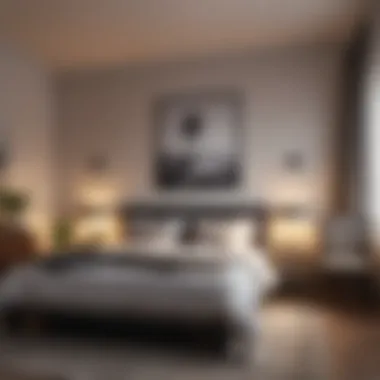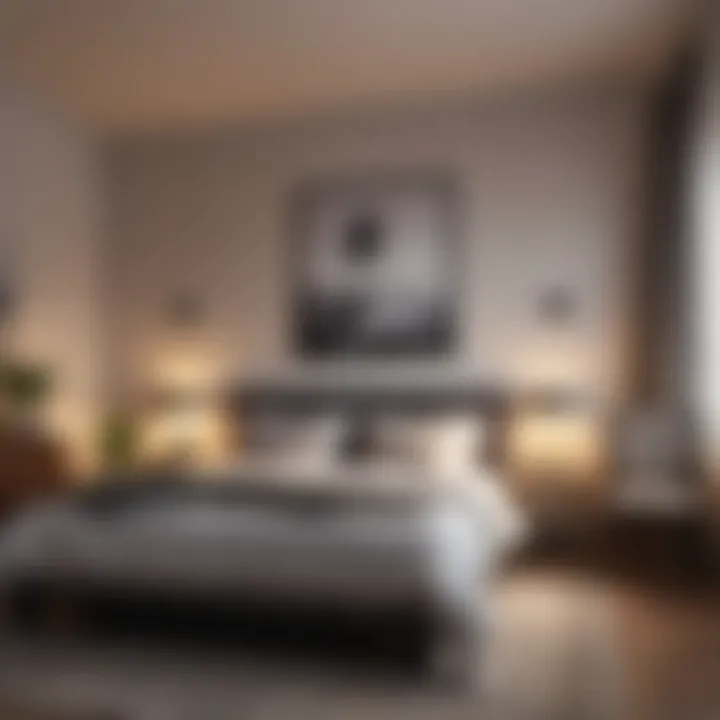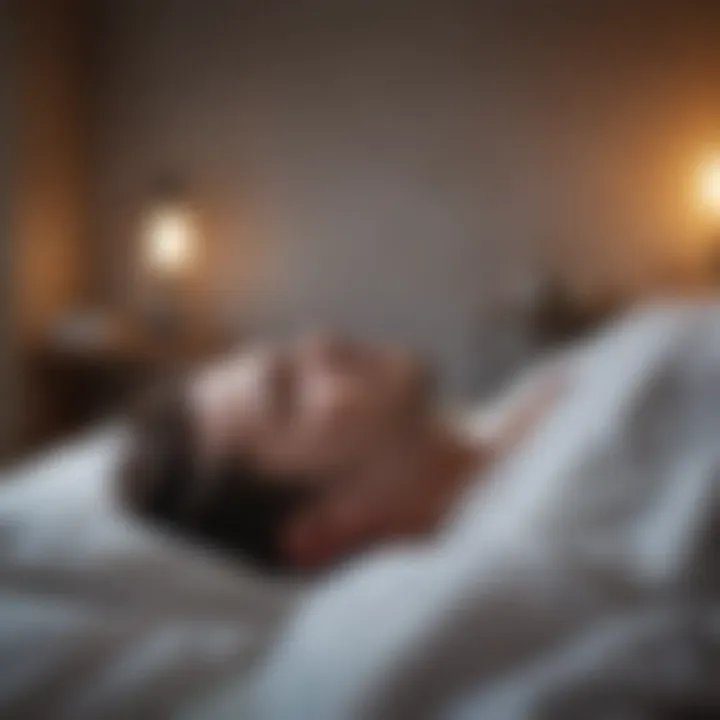Good Sleep Hygiene Practices for Quality Rest


Intro
Sleep is essential to overall health and well-being. This article explores the multifaceted aspects of good sleep hygiene practices. With increasing recognition of the importance of sleep, understanding the behaviors and environments that foster quality sleep has gained traction.
The information presented herein will guide students, researchers, educators, and professionals eager to enhance their understanding of effective sleep strategies.
By meticulously analyzing the barriers to achieving restorative sleep and identifying effective techniques, this article provides a roadmap for improving sleep patterns. Importantly, we emphasize evidence-based research to ensure credibility. This allows for a nuanced exploration of both psychological and physiological factors that influence sleep.
As we delve into this exploration, we will ensure that each section logically follows the previous one, illuminating the profound impact that proper sleep hygiene can have on daily functioning and long-term health.
Research Context
Background and Rationale
Understanding sleep hygiene is critical in today’s fast-paced world. Poor sleep can lead to various issues including reduced cognitive function and increased risk of chronic health conditions. Individuals often overlook the simple adjustments they can make in their daily routines and environments. There is ample research indicating that small changes, such as adjusting lighting or establishing consistent sleep schedules, can lead to substantial improvements in sleep quality.
Literature Review
Past research has focused on numerous dimensions of sleep hygiene. Several studies indicate a strong correlation between sleep habits and physical health. For instance, a review of existing literature highlights interventions such as mindfulness and cognitive behavioral approaches, demonstrating their effectiveness in promoting better sleep. This indicates a need to synthesize knowledge across disciplines—and this article aims to bridge those findings into everyday practices.
Through this examination, we will present a robust discussion of effective sleep hygiene practices, making it clear that improving sleep is achievable. The investigation into behavioral strategies combined with environmental adjustments forms the foundation of our approach.
Understanding Sleep Hygiene
Sleep hygiene practices encompass a variety of behaviors and environmental factors that play a critical role in achieving quality sleep. Understanding sleep hygiene is essential for anyone struggling with sleep issues or who simply desires to enhance their overall sleep quality. Good sleep hygiene can lead to not only improved sleep patterns but also better physical and mental health outcomes.
By understanding sleep hygiene, individuals can identify specific habits that may be undermining their sleep. These can include irregular sleep schedules, overuse of technology, or inappropriate dietary habits close to bedtime. Knowing the principles of good sleep hygiene equips people with the tools to cultivate a more restful environment and enhance their sleep efficiency.
Definition of Sleep Hygiene
Sleep hygiene is defined as a set of practices that are conducive to sleeping well on a regular basis. This concept includes the behaviors surrounding sleep, such as maintaining a consistent sleep schedule, creating a comfortable sleep environment, and developing pre-sleep rituals that promote relaxation. Importantly, sleep hygiene is not solely concerned with the duration of sleep, but also the quality.
Establishing a clear definition is vital for understanding what specifically constitutes good practices. Good sleep hygiene incorporates various elements, ranging from the layout of the bedroom to lifestyle choices and mental wellness.
Importance of Sleep Quality
The Benefits of Quality Sleep
Sleep quality directly influences numerous aspects of life, including cognitive performance, emotional health, and physical wellness. A consistent lack of sleep or poor quality sleep can lead to a decline in cognitive functions, such as memory, problem-solving, and attention. Cognitive decline can hinder daily tasks and the ability to perform effectively at work or school.
Moreover, sleep quality impacts mood regulation. Insufficient sleep can lead to increased irritability, anxiety, and heightened stress levels. Long-term inadequacies can even contribute to chronic mood disorders. Those who engage in proper sleep hygiene often find themselves experiencing improved mood and emotional stability.
Impact of Poor Sleep Hygiene
The repercussions of neglecting sleep hygiene can be detrimental. Poor sleep hygiene may lead to a range of sleep disorders, like insomnia and sleep apnea, which can become chronic issues if left unchecked. Insomnia, characterized by difficulty in falling or staying asleep, can result from stress or irregular sleep patterns.
Additionally, poor sleep hygiene can amplify health risks. Research has shown links between insufficient sleep and conditions like obesity, diabetes, and heart disease. A lack of restorative sleep can compromise the immune system, making individuals more susceptible to illnesses.
To summarize, understanding sleep hygiene is a foundational step toward enhancing sleep quality. With proper sleep practices, individuals can profoundly impact their health, well-being, and daily functioning. It addresses crucial behaviors and environment-related factors that significantly affect one's ability to achieve restful sleep.
Physiological Overview of Sleep
Sleep is a vital process, integral to human health and well-being. Understanding the physiological aspects of sleep helps to appreciate its complexity. This section offers insights into how our bodies control sleep, emphasizing its importance for restoration and overall health. It focuses on the elements of sleep cycles, circadian rhythms, and the role of melatonin, all contributing factors to good sleep hygiene practices.
Sleep Cycles and Stages
Sleep is not a uniform state. It consists of various cycles and stages, each serving different functions. A typical sleep cycle lasts approximately 90 minutes and includes multiple stages which range from light sleep to deep sleep and REM (Rapid Eye Movement) sleep. The progression through these stages is crucial for physical restoration and cognitive function.
- NREM Sleep: Non-Rapid Eye Movement sleep can be divided into three stages:
- REM Sleep: Followed by NREM sleep, REM sleep plays a vital role in memory consolidation and emotional processing. Dreams occur in this stage, highlighting its significance in mental health.
- Stage 1: Light sleep, a transition phase where a person can be easily awakened.
- Stage 2: More stable and deeper sleep, where heart rate slows.
- Stage 3: Deep sleep, essential for recovery and growth. It is during this phase that the body repairs tissues and builds bone and muscle.
"Adequate sleep cycles are vital for various bodily functions, including memory, mood regulation, and overall health."
Regularly achieving a full cycle enhances the restorative benefits of sleep, making it an essential goal in sleep hygiene.
Circadian Rhythms
Circadian rhythms are the body's internal clock, regulating the sleep-wake cycle over roughly 24 hours. These rhythms are influenced by external cues such as light, darkness, and temperature. When properly aligned, they help maintain healthy sleep patterns. Disruptions to these rhythms can lead to issues like insomnia or sleep deprivation.
- Light Exposure: Natural light is crucial. It influences the production of melatonin, signaling the body when to be awake or asleep.
- Consistency: Going to bed and waking up at the same time every day supports a stable circadian rhythm, promoting better sleep hygiene.
The Role of Melatonin
Melatonin is a hormone produced by the pineal gland. It is key in the regulation of sleep-wake cycles, signaling the body that it is time for sleep. As darkness falls, melatonin production increases, promoting feelings of sleepiness.
- Production Factors: Levels of melatonin can be affected by factors such as light exposure and lifestyle choices. Excessive screen time, especially before bed, can inhibit melatonin production, making it harder to fall asleep.
- Supplement Use: Some people consider melatonin supplements to aid sleep. However, these should be used carefully and ideally under supervision of a healthcare provider.
Common Sleep Disorders
Understanding common sleep disorders is essential in improving sleep hygiene and overall health. These conditions not only impact sleep quality but also affect daily functioning, mood, and physical well-being. Recognizing the signs and symptoms of these disorders can lead to more effective treatment approaches and ultimately better sleep outcomes.
Insomnia
Insomnia is one of the most prevalent sleep disorders, characterized by difficulty falling asleep, staying asleep, or waking up too early. This disorder can be transient or chronic, influenced by various factors such as stress, anxiety, or medical conditions. Individuals experiencing insomnia often face mental fatigue, irritability, and decreased productivity.
To address insomnia effectively, it is crucial to identify possible triggers and apply suitable behavioral strategies. Cognitive-behavioral therapy for insomnia (CBT-I) has strong support from research and is widely considered a first-line treatment. CBT-I focuses on changing thoughts and behaviors related to sleep, helping individuals develop healthier sleep patterns over time. Other considerations include avoiding caffeine close to bedtime and establishing a calming bedtime routine.
Sleep Apnea
Sleep apnea is a serious sleep disorder characterized by repeated interruptions in breathing during sleep. Symptoms include loud snoring, gasping for air, and excessive daytime sleepiness.


Obstructive sleep apnea is the most common type, which occurs when throat muscles relax excessively during sleep. This leads to blockages in the airway, resulting in reduced airflow. Untreated sleep apnea can lead to various complications, such as cardiovascular disease, high blood pressure, and metabolic issues.
Maintaining a healthy weight, altering sleep positions, and using airway pressure devices can help manage sleep apnea effectively. In severe cases, surgical interventions may be necessary.
Restless Legs Syndrome
Restless Legs Syndrome (RLS) is a disorder characterized by an overwhelming urge to move the legs, usually accompanied by uncomfortable sensations. These symptoms typically intensify in the evening or during periods of rest, leading to difficulties in achieving restorative sleep.
Identifying potential underlying causes is key in managing RLS. Factors such as iron deficiency or certain medications can contribute to the severity of symptoms. Treatment often includes lifestyle modifications, such as regular physical activity, good sleep hygiene practices, and sometimes medications to reduce sensations.
"Recognizing the symptoms and understanding the underlying causes of sleep disorders can facilitate timely interventions, enhancing sleep quality and, consequently, overall health."
For more information and support, consider visiting resources like Wikipedia and Britannica.
By taking the necessary steps to understand and address these disorders, individuals can pave the way for more restful and restorative sleep.
Creating an Optimal Sleep Environment
Creating an optimal sleep environment is a pivotal aspect of achieving restful sleep. Studies indicate that the surroundings in which one sleeps can significantly impact sleep quality. The goal is to minimize distractions while promoting a sense of comfort and calm.
A conducive sleep environment encompasses various elements, such as the physical conditions of the room, including temperature, noise levels, and lighting. Furthermore, the arrangement of furniture, choice of bedding, and even the colors on the walls can influence how quickly an individual falls asleep and how restorative that sleep is. By addressing these aspects, one can create a personalized space that fosters better sleep hygiene on a regular basis.
Assessing Room Conditions
Assessing room conditions involves evaluating multiple factors within the sleep environment. Elements to consider include the mattress quality, pillow types, and overall cleanliness. A comfortable mattress that supports your body can enhance sleep quality. It’s beneficial to choose materials that are breathable and soft under your skin.
Regular cleaning and decluttering of the sleep space can also improve the ambiance and make it more inviting.
- Mattress: Look for options that suit your body's needs.
- Bedding: Choose materials that enhance comfort.
- Air Quality: Ensure good ventilation to prevent stuffiness.
Temperature Control
Temperature control is another critical factor in establishing an optimal sleep environment. The ideal sleep temperature can vary from person to person, but most studies suggest keeping the room between 60 to 67 degrees Fahrenheit (15 to 20 degrees Celsius). A cool room helps lower the body temperature, which is necessary for sleep onset and maintaining sleep depth. Using appropriate bedding and wearing suitable sleepwear can assist in regulating body temperature.
To maintain optimal temperature:
- Use AC or fans: Helps in adjusting heat levels.
- Consider thermal curtains: They keep direct sunlight from making the room too warm.
- Experiment: It might take time to find the precise temperature range that works for you.
Minimizing Noise and Light
Noise and light are often significant intruders to good sleep hygiene. A quiet, dark space helps signal to the body that it is time to sleep. If external noise is a challenge, consider using white noise machines or earplugs to block disruptive sounds.
To control light:
- Blackout curtains: Effective for creating a dark sleeping area.
- Dimit lights: Before bed, lower the light levels in your home.
- Avoid screens: Limit exposure to screens that emit blue light, which can interfere with melatonin production.
In summary, creating an optimal sleep environment involves careful consideration of room conditions, temperature, and light and noise levels. By addressing these factors, individuals can significantly improve their quality of sleep, leading to better overall health and well-being.
Establishing a Sleep Routine
Establishing a sleep routine is a fundamental aspect of good sleep hygiene. A consistent approach to sleep not only helps regulate the body's internal clock but also reduces the time it takes to fall asleep. Importantly, a well-structured sleep routine fosters better overall sleep quality. Without a routine, individuals can experience varied sleep patterns, leading to difficulties in achieving restorative sleep. Moreover, the benefits of a consistent sleep schedule extend beyond just bedtime; they influence daily energy levels and mood stability.
Consistent Sleep Schedule
Adhering to a consistent sleep schedule involves going to bed and waking up at the same times every day, including weekends. This practice reinforces the body's natural circadian rhythms, making it easier to fall asleep and wake up. Consistency signals the body when to prepare for sleep, enhancing melatonin production. For example, if one aims to sleep by 10 p.m., they should wind down by 9 p.m. to allow the mind and body to relax fully.
Benefits of a Consistent Schedule:
- Improved Sleep Quality: Regularization helps maintain the architecture of sleep cycles.
- Daytime Alertness: A predictable sleep pattern enhances focus and cognitive function.
- Mood Regulation: Regular sleep can prevent mood swings and increase emotional resilience.
Pre-Sleep Activities
Pre-sleep activities are essential for signaling to the body that it is time to wind down. These activities often include relaxation techniques like reading, stretching, or light meditation. Engaging in calming behaviors can help reduce anxiety levels and promote a smoother transition to sleep. Choosing activities that do not involve television or bright screens is crucial as these can disrupt melatonin production.
Suggestions for Effective Pre-Sleep Activities:
- Reading: Opt for a book or magazine with non-stimulating content.
- Gentle Yoga or Stretching: These can help ease tension in the body.
- Mindfulness Meditation: Practicing mindfulness can promote relaxation and reduce the racing thoughts common before sleep.
Limiting Screen Time
In today’s digital age, limiting screen time before bed is more critical than ever. Screens from phones, tablets, and computers emit blue light, which can interfere with the production of melatonin. This disruption can make falling asleep challenging. Aim to avoid screens for at least one hour before bed. Instead, engage in activities that promote relaxation and prepare the mind for sleep.
"Limiting screen exposure at night can significantly improve sleep quality."
Tips to Limit Screen Time:
- Set a Cut-off Time: Choose a specific time each evening to stop using electronic devices.
- Use Blue Light Filters: Many devices offer settings that reduce blue light at night.
- Create a Relaxation Zone: Designate an area in the home for activities that do not involve electronics.
In summary, establishing a sleep routine is an effective means to enhance sleep hygiene. Through consistent scheduling, mindful pre-sleep activities, and limiting screen time, individuals can create a supportive environment for restful sleep. Such habits are not only vital for sleep quality but also positively impact overall health and well-being.
Diet and Nutrition's Role in Sleep
Diet and nutrition play a significant role in influencing sleep quality. The foods a person consumes can affect sleep patterns, metabolism, and body chemistry, which in turn influence restfulness and the ability to fall and stay asleep. For individuals seeking to enhance their sleep quality, understanding the intricate relationship between nutrition and sleep is crucial. Proper dietary choices can alleviate some common sleep disturbances and promote a more restful night.
Timing of Meals
Meal timing is a vital aspect of nutrition that can affect sleep. Eating too close to bedtime may lead to discomfort and disrupt the body's natural readiness for sleep. When one consumes a large meal right before sleeping, the body expends energy to digest the food instead of transitioning into restorative processes that occur during sleep. Therefore, it is generally recommended to finish eating at least two to three hours before going to bed.
Additionally, avoiding late-night snacks can make a difference in sleep quality. If hunger does persist, light snacks that are rich in nutrients, such as a banana or a small bowl of oatmeal, could be more appropriate. These choices can facilitate relaxation instead of causing spikes in energy levels that disrupt sleep.
Caffeine and Alcohol Consumption


Caffeine and alcohol significantly influence sleep patterns. Caffeine, found in coffee, tea, chocolate, and many soft drinks, is a stimulant. It can delay the onset of sleep and diminish sleep quality, particularly if consumed in the later part of the day. Limiting caffeine intake to the morning hours can help mitigate its effects on sleep.
On the other hand, alcohol is often incorrectly perceived as a sleep aid. While it may assist in falling asleep, alcohol typically disturbs the sleep cycle, reducing the amount of time spent in deep sleep stages. This can lead to unrestorative sleep. For optimal rest, it is wise to reduce alcohol intake in the hours leading up to bedtime.
Nutrient Impact on Sleep Quality
Certain nutrients have demonstrated measurable impacts on sleep quality. For instance, magnesium can promote relaxation and aid in falling asleep. Foods rich in magnesium include spinach, nuts, and whole grains. Additionally, tryptophan, an amino acid found in turkey, dairy products, and bananas, is essential for producing serotonin, a precursor to melatonin, the hormone responsible for regulating sleep.
Other nutrients such as vitamins B6 and B12, omega-3 fatty acids, and complex carbohydrates also contribute positively to sleep. A balanced diet incorporating these nutrients can enhance overall sleep quality.
"Sleep is not just a time to recover; it is an essential period for the body’s processes, influenced by the food we consume."
In summary, understanding the role of diet and nutrition in sleep can provide a pathway to improved sleep hygiene. It is important to consider how meal timing, caffeine and alcohol consumption, and nutrient choices converge to affect sleep health. Individuals can leverage these insights to make informed dietary choices that promote a more restful night and improve overall well-being.
Physical Activity and Sleep
Understanding the relationship between physical activity and sleep quality is crucial for anyone aiming to improve their rest. Engaging in regular physical activity has been linked to better sleep patterns. It contributes to both the duration and quality of sleep, leading to numerous health benefits. Exercise helps regulate the body’s circadian rhythms, which in turn plays a vital role in sleep regulation.
Moreover, people who are more physically active experience deeper sleep cycles. This, in turn, allows them to wake up feeling more refreshed. However, it is essential to approach physical activity mindfully, as not all types or timings of exercise yield the same results.
Exercise Timing
The timing of exercise can significantly impact sleep quality. Engaging in vigorous workouts close to bedtime may lead to increased heart rates and heightened alertness, which can delay sleep onset. Generally, it is recommended to avoid intense exercise within two hours of sleep. Instead, exercising earlier in the day can enhance sleep quality. Morning or afternoon workouts help to reset your body's internal clock, promote better sleep, and can also boost your mood and energy levels throughout the day.
On the contrary, light to moderate exercises, such as yoga or stretching, closer to bedtime can be beneficial. These activities promote relaxation and prepare the body for sleep. It's all about finding a balance to enhance your sleep.
Types of Exercise
The kind of exercise you choose can also influence your sleep. Here are some various types:
- Aerobic exercise: Activities like running, swimming, and cycling have shown to improve sleep duration and quality.
- Strength training: Weight lifting or resistance training can lead to more rejuvenating sleep for some individuals.
- Flexibility exercises: Yoga and Pilates not only help in physical well-being but also lower stress levels, thus helping with better sleep.
- Mind-body exercises: Practices such as tai chi combine physical movement with mental focus, further aiding in relaxation and sleep quality.
However, individual preferences and responses to different types of exercise will vary. It is crucial to pay attention to how specific activities affect your sleep pattern. A tailored approach to incorporating physical activity into your routine can yield the best results for your overall wellness.
Regular physical activity is not just about physical health. It plays a vital role in enhancing sleep quality and mental well-being.
Managing Stress and Anxiety
Stress and anxiety significantly impact sleep quality. Establishing good sleep hygiene requires addressing these factors. When the mind is overwhelmed, it becomes difficult to relax and rest. Sleep disturbances often arise from stress or anxiety. Thus, understanding how to manage these issues is not optional; it is essential for achieving restorative sleep.
Stress can be caused by various elements, including work, relationships, and daily life pressures. Addressing these can lead to more peaceful sleep. Anxiety often manifests as racing thoughts, making it challenging to unwind at night. Developing effective management strategies can prevent these thoughts from interfering with sleep.
In the context of sleep hygiene, stress and anxiety management contributes to a stable sleep routine. Studies show that individuals who manage their stress report higher sleep quality. It’s beneficial to adopt specific practices that help regulate stress and calm the mind before bedtime.
Cognitive Behavioral Strategies
Cognitive Behavioral Therapy (CBT) is a powerful approach for managing stress and anxiety. It targets negative thought patterns and behaviors that contribute to these feelings. Practicing CBT techniques can lead to better emotional regulation and enhanced sleep quality.
Some effective CBT strategies include:
- Thought Records: Keeping a daily log of stressors helps identify triggers. Understanding what causes anxiety allows one to address it.
- Cognitive Restructuring: This involves challenging and changing negative thoughts. By reframing thinking, one can reduce anxiety and improve mood.
- Gradual Exposure: Facing fears in smaller increments can help diminish their power. This can enhance coping skills and resilience.
Using these methods, individuals can create a more balanced mindset conducive to relaxation. When the mind is at ease, transitioning into sleep becomes easier.
Mindfulness and Relaxation Techniques
Mindfulness practices and relaxation techniques also play a crucial role in calming the mind. These methods encourage being present and can significantly reduce anxiety. They help cultivate a state of relaxation that prepares the body for sleep.
Some beneficial practices include:
- Deep Breathing: Focusing on breathing can shift attention away from stressors. Take slow, deep breaths to promote relaxation and lower heart rate.
- Progressive Muscle Relaxation: This technique involves tensing and relaxing muscle groups. It helps to release tension, making the body more comfortable for sleep.
- Meditation: Engaging in meditation fosters a sense of mindfulness. Regular practice can steadily reduce anxiety over time.
Mindfulness and relaxation techniques help reduce anxiety, allowing for a smoother transition into sleep.
Developing a personalized plan that incorporates these strategies can enhance one's sleep routine. By focusing on managing stress and anxiety, individuals can create a foundation for better sleep hygiene.
The Impact of Technology on Sleep
The influence of technology on sleep patterns is increasingly relevant in today’s fast-paced society. With smartphones, tablets, and laptops becoming integral to daily life, their effect on sleep quality is an area of significant concern. This section discusses two major aspects: blue light exposure and the use of sleep tracking devices. Understanding these elements can help individuals make informed choices regarding their sleep hygiene.
Blue Light and Sleep Disruption
Blue light emitted from screens can interfere with the body's natural sleep-wake cycle. This is primarily due to its effect on melatonin secretion. Melatonin is the hormone responsible for regulating sleep. Exposure to blue light in the evening can trick the brain into thinking it is still daytime, thus inhibiting melatonin production. Studies have shown that reduced melatonin levels can lead to difficulty falling asleep and poorer sleep quality overall.
Consider these strategies to mitigate the impacts of blue light:
- Use software that filters blue light on devices. Programs like f.lux adjust the color temperature of screens based on the time of day.
- Enable 'night mode' settings available on most modern devices.
- Set a digital curfew by limiting screen time at least an hour before sleep.
"Looking at screens right before bed can severely weaken your body's signals that it's time to sleep."
Additionally, creating a designated technology-free zone in the bedroom can help in promoting better sleep hygiene. The bedroom environment plays a significant role in one’s overall sleep experience.
Sleep Tracking Devices
Sleep tracking devices have gained popularity in recent years, offering insights into sleep patterns and quality. These devices can range from apps on smartphones to wearable devices like smartwatches. While they can provide valuable data, there are key considerations to keep in mind.
- Usefulness: Many people find that tracking their sleep helps them identify habits that may contribute to poor sleep. For instance, they may discover they sleep less after consuming caffeine late in the day.
- Over-reliance: There is a risk of becoming overly focused on numbers and statistics, which can lead to anxiety surrounding sleep. This phenomenon is often referred to as "orthosomnia."
- Accuracy: Not all trackers are created equal. Some devices may not provide a comprehensive view of sleep stages, leading to misinterpretations of data.
In summary, while technology, particularly sleep tracking devices, can enrich understanding of sleep behaviors, individuals must approach these tools with a balanced perspective. Being aware of both the benefits and limitations can aid in maintaining effective sleep hygiene practices.
Supplementation for Sleep Improvement


Supplementation for sleep improvement is an essential aspect of sleep hygiene practices. As individuals strive to enhance their sleep quality, an increasing number turn to various supplements. These can offer a potential solution to enhance sleep patterns while addressing underlying issues contributing to poor sleep. Understanding the types of supplementation available, potential benefits, and the considerations to keep in mind can empower individuals in their quest for restful sleep.
Over-the-Counter Sleep Aids
Over-the-counter (OTC) sleep aids are products widely available without a prescription. Common examples include diphenhydramine and doxylamine. These medications, part of the first-generation antihistamines, are designed to induce drowsiness. They may be effective for occasional use, particularly during short-term disruptions to sleep routines, such as travel or temporary stress.
However, users should consider several factors before relying on these sleep aids:
- Tolerance Development: Over time, the body may develop tolerance, necessitating higher doses for the same effect. This can lead to dependence.
- Cognitive Impairment: Users often report grogginess or confusion upon waking, leading to disturbances in daily functioning.
- Possible Side Effects: Other side effects can include dry mouth, constipation, and urinary retention.
Users must consult healthcare professionals to discuss suitable options and possible interactions with other medications.
Natural Remedies
Natural remedies present an alternative approach to support sleep improvement. Various herbs and natural compounds have been researched for their sleep-enhancing properties. Valerian root, chamomile, and passionflower are popular options. These remedies can be consumed as tea or taken in supplement form.
Benefits of using natural remedies include:
- Fewer Side Effects: Many natural options have a lower risk of adverse side effects compared to synthetic medications.
- Holistic Approach: Natural supplements can support not only sleep but also overall well-being.
- Accessibility: Most natural remedies are available without prescription and can be found in local stores or online.
However, it is vital to keep in mind some considerations:
- Quality Control: The supplement industry is not strictly regulated; thus, quality can vary widely. Purchase products from reputable brands.
- Efficacy: Scientific evidence supporting the effectiveness of these remedies can differ. Research may not always align with anecdotal evidence.
The Role of Professional Evaluation
The significance of professional evaluation in sleep hygiene cannot be overstated. Often, individuals grapple with persistent sleep issues that basic hygiene practices alone cannot remedy. This is where expert help becomes essential. Seeking professional guidance can uncover underlying conditions or disorders that may impede quality sleep. For instances of chronic insomnia or severe sleep apnea, self-management techniques often fall short. Therefore, engaging healthcare providers fosters a comprehensive approach to sleep health.
Professional evaluations help in identifying the root causes of sleep disturbances, which can range from medical conditions to psychological factors. Symptoms like excessive daytime sleepiness, unusual behaviors during sleep, or difficulty falling and staying asleep may indicate a deeper issue. By consulting specialists such as sleep psychologists or neurologists, individuals not only gain clarity but also develop tailored treatment plans.
Additionally, professionals can utilize various diagnostic methods to establish an accurate picture of a person's sleep. This can involve questionaires about sleeping habits and environments, as well as medical histories. These assessments can lead to more effective treatments.
"Realizing when self-care is not enough is critical in managing sleep problems effectively."
When to Seek Expert Help
Knowing when to seek expert help is crucial. Here are key indicators:
- Persistent sleep issues lasting beyond a few weeks.
- Significant lifestyle impacts due to sleep deprivation, such as difficulty focusing at work or studies.
- Experience of sleep apnea symptoms, like loud snoring or pauses in breathing during sleep.
- Presence of underlying medical conditions that may affect sleep, like anxiety or depression.
If you notice these signs, consulting a specialist is advisable. They can lead you through a thorough evaluation process and help delineate between typical sleep challenges and more serious conditions that require intervention.
Sleep Studies and Assessments
Sleep studies, also known as polysomnography, represent a standard diagnostic tool in evaluating sleep disorders. These comprehensive assessments take place in controlled environments, typically sleep clinics or laboratories. During a sleep study, several vital metrics are monitored, including brain waves, oxygen levels, heart rate, and body movements. This information contributes to a holistic understanding of an individual's sleeping patterns and issues.
Several types of sleep studies exist:
- In-lab polysomnography: Conducted overnight at specialized facilities with skilled technicians monitoring conditions.
- Home sleep study: A more accessible option where patients wear portable devices at home to track sleep-related metrics.
Both options have their benefits. In-lab studies may provide in-depth data, essential for complex cases, while home studies offer convenience for those who might feel anxious in a clinical setting.
Cultural Perspectives on Sleep
Cultural perspectives on sleep offer invaluable insights into how different societies approach this fundamental aspect of life. Sleep is not merely a physiological necessity but also a cultural construct influenced by historical, social, and environmental factors. Understanding these cultural variances can enhance the practices surrounding sleep hygiene, providing a more holistic view that embraces diverse lifestyles.
Sleep practices differ significantly across the globe. For example, in many cultures, communal sleeping arrangements are common. This can enhance feelings of security and comfort, contributing to better sleep quality. In contrast, Western societies often emphasize individual sleeping spaces, which may lead to feelings of isolation or increased stress for some individuals. Recognizing these different practices is essential for adopting effective sleep hygiene strategies tailored to individual needs.
Global Sleep Practices
Around the world, sleep customs are deeply rooted in cultural traditions and community values. For example:
- In Japan, a practice known as "inemuri" allows people to sleep in public spaces, reflecting the cultural acceptance of napping as a way to recharge.
- In Spain, the siesta is a common practice, where families take a midday break to rest, helping to mitigate the effects of a late evening.
- Scandinavian countries often prioritize minimalistic bedroom designs to promote calm, which enhances the sleeping experience.
The way societies view sleep can influence behaviors and attitudes towards sleep hygiene. Integrating such practices can improve sleep quality while also respecting and honoring cultural differences. Learning about these customs fosters a more inclusive approach to sleep hygiene, where individualized solutions consider a person's cultural background and existing practices.
Impact of Lifestyle and Values
Lifestyle choices and societal values greatly affect sleep habits and quality. In cultures that prioritize work and productivity, like in the United States, there may be a tendency to sacrifice sleep for career advancement. This can lead to chronic sleep deprivation and associated health problems. Conversely, cultures that value balance and leisure often incorporate activities that promote relaxation, directly supporting better sleep hygiene.
Consider the following impacts:
- Work-life balance: Cultures that emphasize work-life balance encourage restorative practices, such as regular family meals and downtime, which can improve sleep.
- Social connections: In cultures where social networks are strong, emotional support is readily available, which can alleviate stress and anxiety, promoting better sleep.
- Values around health: In cultures that prioritize holistic health, there is often a greater emphasis on sleep as an integral component of overall well-being.
Understanding these influences can guide individuals and health practitioners in crafting personalized and culturally sensitive sleep hygiene recommendations, promoting better sleep outcomes across diverse populations.
"Cultural beliefs and practices around sleep play a critical role in shaping individual sleep behaviors and attitudes."
Exploring cultural perspectives on sleep enables a comprehensive examination of how environmental, social, and psychological factors converge to influence sleep hygiene. This multi-faceted approach enriches our understanding and supports the development of effective strategies tailored to meet varied needs, thereby contributing to overall sleep quality.
Future Directions in Sleep Research
Understanding sleep is a complex endeavor that involves ongoing exploration and research. The significance of future directions in sleep research is paramount, especially within the context of improving sleep hygiene practices. As our knowledge expands, new insights can emerge that lead to enhanced strategies for achieving quality sleep. This section outlines potential future advancements in sleep research that could reshape how individuals manage their sleep hygiene.
Emerging Technologies
With the rapid advancement of technology, new tools and devices are being developed to monitor and improve sleep quality.
- Sleep Monitoring Devices: Wearable technology like fitness trackers and smartwatches can provide data on sleep patterns. This information helps individuals understand their sleep cycles and make necessary adjustments to their routines.
- Apps and Software: Many applications now offer tailored sleep strategies, including guided meditations and relaxation exercises. Users can access these tools at their convenience, promoting better pre-sleep habits.
- Artificial Intelligence: AI can analyze sleep data, offering personalized recommendations based on user behavior. As AI evolves, it could facilitate more sophisticated, individualized sleep interventions.
These technologies not only aid in the understanding of sleep behaviors but also contribute to the development of proactive measures that people can implement for better sleep hygiene.
Interdisciplinary Approaches
Sleep research is increasingly benefiting from interdisciplinary collaborations, fusing insights from various fields to tackle the challenges of sleep disorders and hygiene.
- Psychology and Sleep: The intersection of psychology and sleep research highlights how mental wellness affects sleep quality. Understanding psychological factors can inform better treatment protocols that address sleep disorders holistically.
- Neuroscience Contributions: Neuroscience provides insights into the biological mechanisms that underlie sleep. Research in this discipline can lead to innovative methods for addressing common sleep issues.
- Public Health Perspectives: Exploring sleep hygiene from a public health angle can identify community-level interventions. By assessing demographic and socioeconomic factors, researchers can promote effective sleep hygiene practices on a wider scale.
Integrative approaches can yield a richer understanding of the multifaceted nature of sleep. Each discipline brings unique insights, allowing for more comprehensive solutions to improve sleep hygiene practices.



